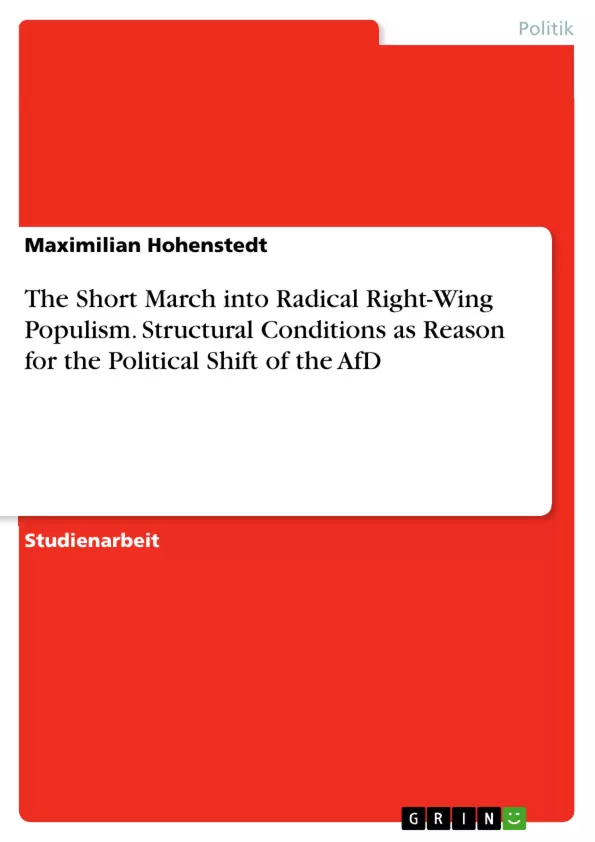The question of this work is: Why shifted the AfD itself onto the radical right-wing populism between 2013 and 2017?
It will be shown, that AfD changed itself through the change of issues which is reasoned in the close responsivity to their followers reasoned in the structural construction of a new populist party. It will be the aim to illustrate, that the use of the new social media (NSM) beside the media strategy formed this trend onto RRP. So, the shift to the RRP was mainly a result of structural conditions. The close responsivity to possible followers via NSM became the reason of the choice of the migration-issue and together with AfDs strategy of political communication, this brought the party step by step onto the radical right.
This work will contribute its part to answer the question of why this is happening and if CPP are more likely to shift onto right. The structural conditioned chain shall get unraveled, which is causing the radicalization process beyond personal power struggles, which are result, but not reason of this shift onto the right. Strong responsivity via NSM caused issue decisions, benefiting the national-conservative wing and media strategic decisions, promoting more radical streams. The therefore constructed party affiliation outside the mainstream as “pariah-party” additionally boosted the radical forces.
The Alternative für Deutschland is the most successful new-founded party on federal level in Germany since the 1950s. Being a single-issue-eurosceptical party in 2013, as widely accepted in political science because of the focus to the european financial policy and the german role in it, the AfD changed in the next years to a radical right-wing populist party, as it will get expounded. Presented as centrist populist party the AfD came with the success in a state of radicalization onto right, turning the “Professoren-Partei” into the “Wutbürger-Partei”.
At the beginning, the party was active in an economist-liberal manner to deny the “there is no alternative (TINA)”-policy in terms of the european financial safety net, framing the european financial crisis as “euro-crisis” and the EFSN as “barrel without ground”. Later, the party picked up early the migration-issue and turned itself step by step into radicalism by framing successful the migration-issue as “loss of control” instead of “task and chance”.
Inhaltsverzeichnis
- 1 Introduction
- 2 Main section
- 2.1 Analysis grid: anti-establishment, populism, right wing and radicalism
- 2.2 Organic radicalization: The structural change by direct networks
- 3 Conclusion
Zielsetzung und Themenschwerpunkte
Die vorliegende Arbeit untersucht den Wandel der Alternative für Deutschland (AfD) von einer euroskeptischen Anti-Establishment-Partei zu einer radikalen Rechtspopulistenpartei (RRPP) im Zeitraum zwischen 2013 und 2017. Im Mittelpunkt steht die Frage, welche Faktoren diesen Wandel beeinflusst haben und wie die Partei im Kontext des Aufkommens neuer sozialer Medien (NSM) ihre Strategie angepasst hat.
- Analyse des Wandels der AfD von einer euroskeptischen Partei zu einer RRPP
- Bedeutung der neuen sozialen Medien (NSM) für die Radikalisierungsprozesse
- Differenzierung zwischen Anti-Establishment-Parteien (AEP), Populistenparteien (PP) und Radikalen Rechtspopulistenparteien (RRPP)
- Rolle der politischen Kommunikation und der Medienstrategie in der Radikalisierung
- Strukturbedingte Faktoren, die die Radikalisierungsprozesse beeinflussen
Zusammenfassung der Kapitel
- Kapitel 1: Introduction: Das Kapitel stellt die AfD als die erfolgreichste neu gegründete Partei auf Bundesebene in Deutschland seit den 1950er Jahren vor und beleuchtet ihren Wandel von einer euroskeptischen Partei zu einer RRPP. Es wird die Relevanz dieser Thematik für die politische Wissenschaft und die Gesellschaft hervorgehoben.
- Kapitel 2: Main section, 2.1 Analysis grid: anti-establishment, populism, right wing and radicalism: Dieses Kapitel entwickelt ein Analysekasten, um die verschiedenen Begriffsbezeichnungen im Kontext von AEP und Populismusparteien (PP) zu differenzieren. Es werden Anti-Establishment-Reform-Parteien (AERP), Zentristen-Populisten-Parteien (CPP) und Radikal-Rechtspopulisten-Parteien (RRPP) abgegrenzt und definiert. Es wird gezeigt, dass die AfD in ihrer Anfangsphase eher als CPP anzusehen war und zu welchen Zeitpunkten sie sich in andere Partei-Typen verwandelte.
Schlüsselwörter
Die Arbeit konzentriert sich auf die Themen Anti-Establishment-Parteien (AEP), Populismus, Rechtspopulismus, Radikalisierung, politische Kommunikation, neue soziale Medien (NSM), Medienstrategie, Alternative für Deutschland (AfD), Europa, Eurokrise, Migrationskrise, Strukturbedingungen.
- Quote paper
- Maximilian Hohenstedt (Author), 2018, The Short March into Radical Right-Wing Populism. Structural Conditions as Reason for the Political Shift of the AfD, Munich, GRIN Verlag, https://www.grin.com/document/428173



